A Magnificent Masterpiece in Istanbul, the Meeting Point of Religions: Ayasofya
Hagia Sophia is one of the most important places in Istanbul with its glorious history. In this sense, it is one of the first places that you should see when you come to Istanbul. But since Hagia Sophia has very detailed qualities, it is important to get information before visiting. For your benefit, in this article, we will talk about the location of Hagia Sophia, its importance for Istanbul and the world, its history, the dates and times of visits, and everything a tourist needs about Hagia Sophia. Hagia Sophia is the key to a sacred journey to share this glorious history with your eyes and your whole soul. It draws attention especially with its importance in terms of the history of religions, the empires and civilizations it has witnessed and all the cultural elements it hosts.
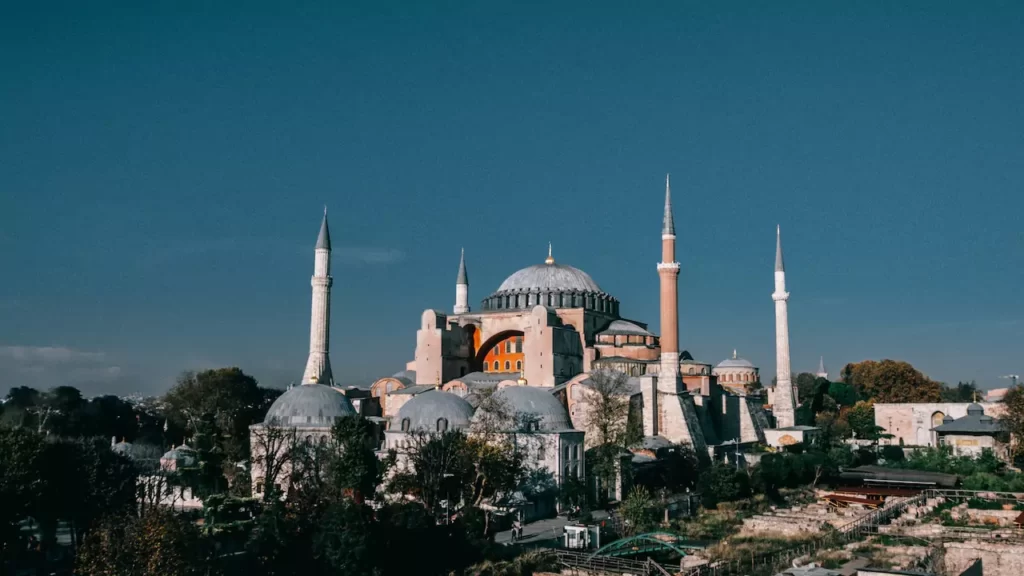
Hagia Sophia, one of the Most Visited Places in Istanbul
At the point where the first foundation stones of Istanbul were laid, Hagia Sophia, a dazzling place with its imposing structure in Fatih Suriçi, is home to a cosmopolitan structure just like Istanbul. It was built during the Roman period, when the foundations of European civilization were laid, by the order of Emperor Constantine I, the first to accept Christianity. When Constantine, who laid the foundations of Istanbul, built Hagia Sophia, which has become the symbol of the city, it was known as the largest church in the world and was called Megale Ekklesia, the Great Church. Although it was rebuilt several times due to some architectural problems, it still preserves its great splendor and greets old Istanbul with its great majesty for you to see…
Although Istanbul is one of the world’s leading cities in many respects, it draws attention as the meeting point of Christianity and Islam. Hagia Sophia, just like Istanbul, is the meeting place of two great religions. Converted to a mosque in 1453 with the conquest of Istanbul, the Great Church attracts attention with its architectural revolution with its dome. Especially the frescoes in its interior, which emphasize historical events, are worth seeing. In this sense, as the fastest-built place of worship in the world and as a representation of paganism, Orthodox/Catholic Christianity, and Islam, it carries the spirit of the Holy Jerusalem. In this sense, you should definitely visit this unique monument to revisit Rome and old Istanbul and embark on a spiritual journey.

Hagia Sophia as a Historical Witness
Hagia Sophia is a work that has been destroyed and rebuilt many times since it was first built. In this sense, there have been certain construction periods in its history as well as different civilization periods. As we mentioned above, the foundations were laid in 532 and the work was completed in 537. But this completed Hagia Sophia is referred to as the “Third Hagia Sophia”. As we mentioned, the first two Hagia Sophia were destroyed due to various reasons such as earthquakes.
Hagia Sophia, a Roman architecture, was famous for the innovations it brought especially in architectural fields and the title of the largest cathedral in the world until the Seville Cathedral, which was completed in 1520. It is also known as the oldest cathedral in the world. In this process, it also witnessed great events such as the separation of the eastern and western churches. As a result of the dissolution of Rome and the separation of churches, it served Christianity as the center of the Eastern Orthodox patriarchate during the Byzantine period. As a result, with the conquest of Constantinople, it engraved its name on a period that would cause great changes in the entire field of Islamic architecture. After 1453, Hagia Sophia, which was converted into a mosque, served the history of world culture as a museum from the first years of the Republic until July 2, 2020. After that, with the decision taken on July 2, 2020, it gained mosque status again. In this sense, Hagia Sophia draws attention as a historical witness to the events that shaped world history. Hagia Sophia, which has almost the same value as the history of Istanbul, is like a time machine built for you to travel in time.
Where Does Hagia Sophia Get Its Name?
The name Hagia Sophia used today comes from the ancient Greek words “Agia Sofia”. These words, which mean Holy Wisdom, it is also referred to by titles such as the Great Church. The word “Agia”, meaning “Aya”, means sacred, while the word “Sofia”, meaning “Sofia”, comes from the ancient Greek word “Sophos”, which means wisdom. In particular, it symbolizes “Holy Wisdom”, one of the three attributes of God, which are the cornerstones of Christian philosophy and attributed to Jesus. In this sense, it carries a holiness like the holiness of Jerusalem. With such qualities, Hagia Sophia is a masterpiece that you should visit for a spiritual journey with its mystical atmosphere.

Did you know that Hagia Sophia was built as a church?
During the Roman period, the main belief was paganism. Constantinus I, the Great Roman Emperor who gave his name to Istanbul, converted to Christianity. He then ordered the construction of a church based in the center of ancient Istanbul. However, when his life was not enough to complete it, it was inaugurated by his son Constantius II on February 15, 360. It was known as the largest church in the world until the Seville Cathedral was built. It also served the two major sects of Christianity, Orthodox, and Catholic. In this sense, just like Istanbul, it rises with its splendor in a synthesis of cultures.
A Turning Point in Architecture
Hagia Sophia, which embodies important features at many points in the architectural field, has created a turning point, especially with its being a domed basilica-type space, dome transitions, and carrier architectural systems. It has achieved great innovation both aesthetically and technically. The fact that its dome covers a large part due to its construction technique reveals how effective it is in terms of architecture.
Standing for 1500 years and actively contributing to the history of humanity and culture, this masterpiece:
- is the oldest cathedral in the world,
- was the largest cathedral in the world from the time it was built until 1520, when the Seville Cathedral was inaugurated,
- is the fastest-built cathedral in the world (5 years),
- is the world’s longest-standing place of worship,
One of its biggest features is its domed structure. This dome architecture influenced the mosque architecture after it was included in the Islamic civilization and all the mosques built after that had domed architecture. Throughout the history of Hagia Sophia, the dome has cracked and even collapsed due to earthquakes and various effects. The height of the dome over the main space is 55.60 meters, the north-south diameter is 31.87 meters and the east-west diameter is 30.86 meters. In this sense, it has been renovated and strengthened many times. In addition, with its truly spectacular structure and aesthetic appearance, it is an architectural technique that you should definitely see with the eyes of the world.
During the period when Hagia Sophia was a church, many figures attract attention. One of them is the figure of Jesus in the main dome. There are some rumors about this figure. The first of these is that after it was converted into a mosque, all figures and human faces were covered with plaster except the figure of Jesus. However, this Christ figure was covered with a verse engraved by Kazasker Mustafa İzzet Efendi in the 17th century. The second rumor is that the figure fell during the earthquake of 1894.
There are various frescoes on the transitions from the domes to the piers. The most striking of these are the frescoes of four angels. Apart from these, there are frescoes of Jesus, Mary, Constantine I, and Constantius II in many places, especially on the upper floor. There are also frescoes of beings and people who are considered sacred for Christianity. In this sense, you will be fascinated to see the traces of Christian philosophy and Roman civilization on the walls of Hagia Sophia.
After Hagia Sophia was converted into a mosque, a mihrab was built. This mihrab is located in the eastern part of the building. Although various repairs and additions were made under different sultans, it took its current form in the 19th century. On either side of the flamboyant mihrab, decorated with a half-domed chandelier and gold stars, are candlesticks brought from the palace church of Matyas I after the Budin Campaign of Suleiman the Magnificent. These candlesticks reveal all the splendor of Ottoman civilization before your eyes.
Since Hagia Sophia is a large complex, it also has a library. This library was founded by Mahmut I. In addition, this library contains 4000 artifacts with a great collection value. These works were moved to the Süleymaniye Library in 1968. But there is no need to be sad because there are still some embroideries and decorations in the library.

Hagia Sophia’s Exterior
The exit door on the lower floor leads to the courtyard. The first place to be seen here is the fountain built during the reign of Mahmut I, which serves for men to perform ablution before prayers. The door to the left of the courtyard leads to the mausoleums. These are the mausoleums of Selim II, Murad III, Mehmed III, Sultan Mustafa, Sultan Ibrahim, and different princes. During the restoration of the mausoleums, the largest baptismal pool known to date from the early Christian period, before the 6th century, was discovered. A “Sıbyan Mektebi” building for children’s education is also located in the courtyard. Other buildings in the courtyard are used for administrative services.

Hagia Sophia’s Interior
The interior attracts attention with its two-story structure. Especially the mihrab, khünkar mahfil, minbar, muezzin mahfil, the marble pulpit built by Murad IV, the jars from Bergama, the sweating column, and the treasure room on the lower floor are the sections that attract attention. Apart from these, there are various mosaics, frescoes, embroidery, and ornaments mentioned above.
On the upper floor, there are the gates of heaven and hell, the empress lodge, and important mosaics.
Here are some buildings that may be of interest to you at this point:
- Empress Pavilion
- Viking Graffiti
- Monument to Enrico the Crusader
- Deesis Mosaic
- Gabriel Mosaic
- Emperor family figures




A History from Church to Mosque: Hagia Sophia
From the time it was built until 1453, it served the two major sects of Christianity, Orthodox and Catholic, as a church. It is a work that witnessed many events during this process. The most important of these is the division of churches as east-west. After this event, Hagia Sophia became the center of the Orthodox sect. In 1453, after Fatih’s conquest of Istanbul, it was converted into a mosque and served Islam until the first years of the Republic. In 1934, it was decided to turn it into a museum with the decision of the council of ministers taken by the order of Atatürk. It was turned into a mosque again with official decisions taken in 2021 and today, it serves both as a place of worship serving the Islamic world and a museum serving the world’s cultural heritage.
Hagia Sophia as a Church
After the 1st and 2nd Hagia Sophia, which served as churches, Emperor Justinian wanted to build a more magnificent church than the previous emperors. He chose the physicist Isidoros of Miletus and the mathematician Anthemius of Tralles for this construction. There are some legends about its construction. The first one is that Justinian did not like any of the drafts, so Isidoros fell asleep while working on the drafts at night and when he woke up in the morning, he found the draft of Hagia Sophia ready in front of him. According to the second legend, Isidoros saw the plans of Hagia Sophia in his dreams. In this sense, Hagia Sophia, which has a mystical side that is the subject of legends, is one of the main places that you should make a truly magical visit.

Ayasofya as a Mosque
It was opened as a mosque in 1453 as a sign of the conquest of Istanbul. When Istanbul was captured, Hagia Sophia was in a dilapidated state. Fatih ordered that Hagia Sophia be cleaned, restored, and turned into a mosque. After the order, the first minaret was erected. Fatih gave so much importance to Hagia Sophia that even though the Ottomans used stone in such buildings, bricks were used to finish the construction of the minaret quickly.
Apart from all these, minarets and different space additions were made by various sultans over the years. During this period, Fatih did not change the name of Hagia Sophia and it has been called by this name until today.

Hagia Sophia as a museum
With the restoration of Hagia Sophia in 1934, its re-conversion into a church was put on the agenda. The main purpose of this was to emphasize Turkey’s principle of secularism. However, it was decided to turn it into a museum due to the small Christian population, possible reactions and possible damage to its historical symbol. After this, the carpets on the floor and the plaster covering the human figures were removed. Hagia Sophia, which was turned into a museum by the order of Atatürk himself, served the world cultural heritage as a museum until 2021.
Hagia Sophia today
Even though it was on the agenda to turn it back into a mosque in various periods of the Republic of Turkey, this did not happen. Especially in 2020, various celebrations were held at Hagia Sophia on May 29, the anniversary of the conquest of Istanbul, which brought the issue of turning it back into a mosque to the agenda. Following this, it was turned into a mosque in 2021 with the judicial process. However, this was met with a backlash in the international arena and UNESCO announced that Hagia Sophia would be reconsidered for the World Heritage list. But despite all this, Hagia Sophia is still standing tall to welcome you as a representative of Istanbul and multiculturalism.
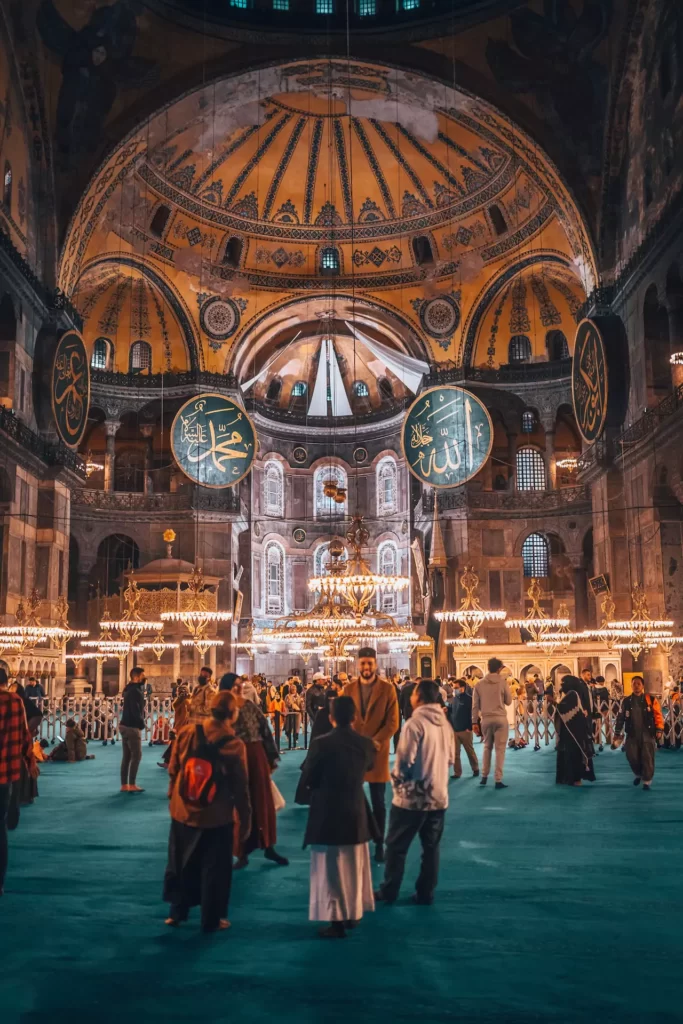
Tourist advise for your first visit
There are some points you should pay attention to before visiting Hagia Sophia, one of the most important cultural centers of the world. If you pay attention to these points, you will be enchanted by the magic of Hagia Sophia. At this point, Hagia Sophia, which dazzles the eyes with all its splendor, is a masterpiece representing Istanbul with its interior mosaics, frescoes, and different venues.
Opening Hours and best times to visit the Hagia Sophia
After Hagia Sophia was converted into a mosque, it became a place that serves 24/7. At this point, it is possible to visit Hagia Sophia at any time of the day. However, at this point, you will need to pay attention to certain hours for you to have a more enjoyable sightseeing process. At this point, you should especially avoid visiting during prayer times and Friday prayers.
Hagia Sophia is a historical site that is generally busy from 12 noon to 5 pm. Since tourist tours are usually between these hours, there will be a high density of people. If you want to visit on your own, you may prefer the early morning or evening hours.
During the summer season, many tourists come to Istanbul just like you. At this point, in the summer season, Istanbul’s tourist attractions are very crowded. Therefore, it will be more advantageous for you to visit in other seasons. If you have some question marks about the time of your visit before planning a trip to Hagia Sophia, you can visit the article on the best time to visit Istanbul for more detailed information.
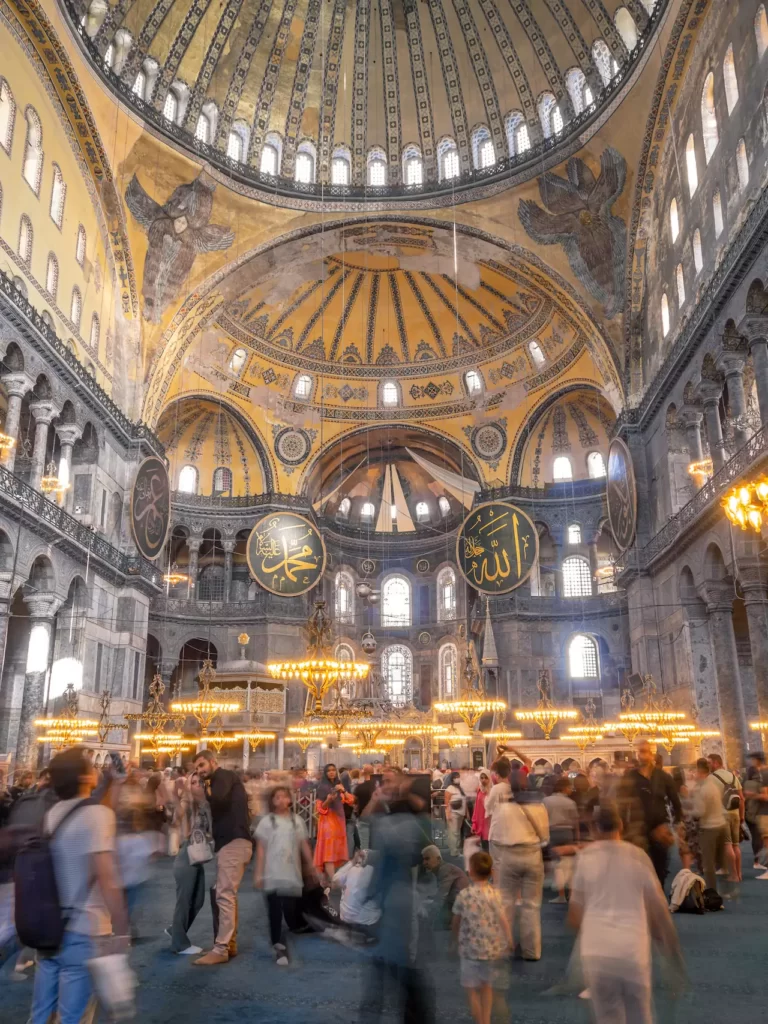
Where is the Hagia Sophia and how to get there?
Hagia Sophia is a historical building located in Sultanahmet. You can use the T1- Kabataş-Bağcılar tram line to get here. If you get off at the Sultanahmet stop on the tram, you can easily reach Hagia Sophia. Some bus lines of IETT can also be used to reach Hagia Sophia. However, since these lines are extremely confusing for you, you can get there by tram. To get on the tram, you need an Istanbulkart or a limited-use card that can be purchased at Istanbulkart loading points.
Entrance Fees and Tours
Although the entrances were paid for when Hagia Sophia was a museum, it serves completely free of charge after it was converted into a mosque. You do not need to pay any entrance fee at this point. In addition, entrance to places such as tombs included in Hagia Sophia is completely free of charge. However, it will be beneficial for you to get a Museum Card or Museum Pass Istanbul. With these two cards, you can easily visit the places around Hagia Sophia such as Topkapi Palace, Basilica Cistern, and the Museum of Turkish and Islamic Art.
Different companies have tours of Hagia Sophia and other places around it. These tours have different qualities, including guided and unguided, and therefore different prices. If you want to visit such places with detailed information and decorate your visit with information, you can take a look at guided tours.
Can you pray in the Hagia Sophia?
After being converted into a mosque in 2021, Hagia Sophia serves as a place of worship where you can pray 5 times a day, including Friday and Eid prayers. In this sense, if you want to turn your pleasant visit into a spiritual ritual, you can do so in the section reserved for prayer.
How Should You Dress When Going to the Mosque?
Keeping in mind that this is a place of worship and taking into account the rules of the Islamic faith, you should pay attention to some aspects of dress. First of all, you should cover your knees, shoulders and upper arms. Do not forget to take off your shoes when you enter. For this, you can bring an item such as a bag to carry your shoes. In addition, if you are a woman, you should also cover your hair. Learn more about the dress code in the Hagia Sophia and Blue Mosque.


Places You Can Visit Around Hagia Sophia
Hagia Sophia is a place called Old Istanbul and is located in the center of historical Istanbul. In this sense, there are some touristic places around it that have similar historical and cultural features. After visiting Hagia Sophia, you can easily visit these places on foot. Here are some places close to Hagia Sophia:
- Spice Bazaar
- Grand Bazaar
- Gulhane Park
- Topkapi Palace Museum
- Basilica Cistern
- Hagia Irene
- Blue Mosque
- Museum of Turkish and Islamic Art
Accommodation Suggestions for Visiting Hagia Sophia
Do you want to visit Istanbul but haven’t decided where to stay? There is no need to worry about this. Because with some tips, you can decide on the location where you can easily reach all the places to visit and where you will stay in quality accommodation. At this point, first of all, you should remember that most of Istanbul’s historical sites are on the European side. Because during the Roman and Ottoman periods, Istanbul rose on the European side. In this sense, all historical and touristic places are located here. Staying in locations close to these places will ensure that we do not have transportation problems while visiting the tourist attractions mentioned above. Districts such as Eminönü, Beyoğlu, and Taksim may be the most ideal districts for you. For detailed information on this subject, you can visit the article about the best places to stay in Istanbul for the first time.
Frequently Asked Questions About Hagia Sophia

Although Hagia Sophia was first built by Constantine I, the present Hagia Sophia was built by Isidoros of Miletus and Anthemius of Tralles on the orders of Emperor Justinian I.
The first Hagia Sophia was inaugurated in 360, but today’s third Hagia Sophia was completed in 537.
Hagia Sophia is located north of Sultan Ahmet Square and south of Cankurtan in the Fatih district of Istanbul, known as Old Istanbul. Sultan Ahmet, Hagia Sophia Square No:1, 34122 Fatih/Istanbul
Hagia Sophia is a combination of the ancient Greek words Hagia and Sophia and means Holy Wisdom.
The first Hagia Sophia was built after Constantine I converted to Christianity and wanted to build a place of worship. The third Hagia Sophia, today’s Hagia Sophia, was built after Justinian wanted to build a church even bigger than Constantine’s.
Blue Mosque is the name given to the Sultanahmet Mosque. This is due to the blue tiles used in its decorations. Hagia Sophia is called the Church of Holy Wisdom or the Great Church.
With the conquest of Istanbul, the domed structure of Hagia Sophia influenced the architecture of Turkish-Islamic mosques and the mosques built after the conquest of Istanbul started to use domes. Therefore, Süleymaniye Mosque is similar to Hagia Sophia.
With the decisions taken in 2021, Hagia Sophia regained mosque status from museum status.
Hagia Sophia was the largest church in the world until the Seville Cathedral was built. It has also gained a sacred character as it serves all three major faiths.
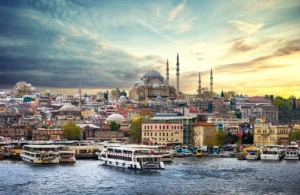




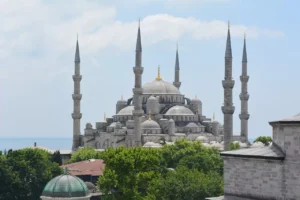
[…] Hagia Sophia […]
[…] Hagia Sophia […]
[…] Hagia Sophia […]